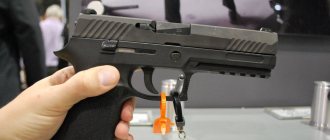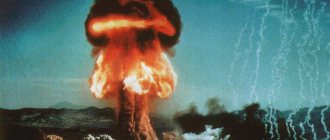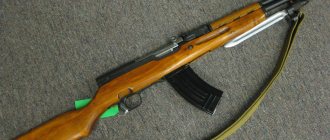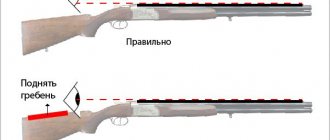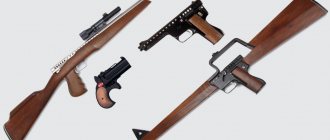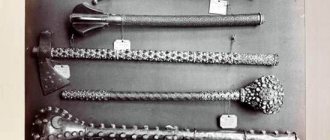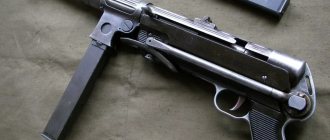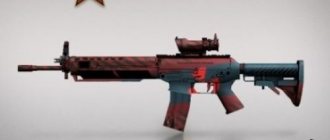PP K6-92 "Borz"
In the fight against Russian military personnel, Chechen rebels use improvised weapons. Umalt Dudayev, Grozny Central market of the Chechen capital - the city of Grozny. A chilly day in early April. A short young man in a black jacket and jeans, with a knitted cap pulled far down over his eyes, quickly walked up to two Russian officers buying cigarettes and beer at a small mud-stained kiosk. Having caught up with the military, the young man suddenly grabbed a short-barreled machine gun from under his jacket and opened fire on the unsuspecting officers. Then, throwing his weapon next to the bodies of the dead, the young man quickly took a pistol from the holster of one of the Russian officers, picked up a machine gun lying next to another body and disappeared into a nearby alley. After some time, officers from the military commandant’s office and Chechen police arrived at the scene, but found no evidence other than a Chechen-made “Borz” (Wolf) submachine gun thrown near the dead. “A native” of Chechnya, “Borz” is one of the types of weapons that, if not in their original form, then converted or repaired right there in Chechnya, form a powerful - due to their availability and low cost - arsenal at the disposal of enemy forces hostile towards Russian military personnel and employees of the pro-Moscow law enforcement agencies of the republic. With this arsenal at their disposal, the rebels do not have to fear being left unarmed if the federal authorities manage to put an end to the theft of weapons, illegal trade and their sale to pro-independence forces. The 9mm Borz submachine gun is ideal for surprise attack tactics. This is a small, compact weapon, whose light weight and ease of handling successfully neutralize the shortcomings of its performance characteristics. “This submachine gun has very low tactical and technical characteristics,” says Major Anatoly Medvedev, an officer of the Federal Security Service of the Russian Federation for Chechnya. — The 9-mm “Makarov” cartridge that Borz fires is too powerful for the steel from which the weapon’s barrel is made, and quickly wears it out. After 2-3 horns fired, the Borz simply begins to “spit” bullets.” “However, I would call this weapon ideal for saboteurs and killers. It fully justified its purpose as a weapon for guerrilla-type paramilitary forces. It has a fantastic rate of fire, and once you've used up all the ammo, you can simply throw it away. “Borz,” according to my information, was very cheap in Chechnya, about 100 US dollars, and its production does not require much effort or expense.” The production of the Borz submachine gun began in Grozny in 1992 by order of the first Chechen president. The President of Chechnya, General Dzhokhar Dudayev, also received the first copy of the Borz, numbered 0001. However, the industrial production of this weapon was soon discontinued due to a lack of quality metal and the outbreak of war (1994), but the artisanal production of these submachine guns continued until recently. As the head of the scientific department of the Central Museum of the Armed Forces of the Russian Federation, Vladimir Semchenko, told an IWPR correspondent, the main military museum of the country has several copies of Chechen Borz submachine guns. “One of them was donated to our museum by General Gennady Troshev (who formerly commanded Russian troops in Chechnya). The samples of these weapons we have differ from each other both in technical characteristics and in appearance, which shows the artisanal nature of their manufacture.” The former head of the workshop, Adlan Musayev, claims that “only a few hundred real ones were produced.” “It was then that all sorts of “handicraftsmen” rushed to rivet some kind of “Borz” and sell them to gullible weapon lovers, passing them off as new samples of the “Wolf”. But it was all just a parody of weapons,” he said. The presence of homemade weapons allowed the Chechen rebels to continue their resistance, especially during the second military campaign that began in 1999. The rebels do not have their own heavy weapons, but they show great ingenuity in converting random objects into weapons. A major role in the sabotage and subversive activities of the Chechen partisans is played by their ability to make homemade explosive devices to blow up military vehicles and columns of federal forces. For these purposes, due to a chronic shortage of factory mines, they use all kinds of ammunition, such as unexploded mines, shells, rockets, etc. In other cases, militants simply line the shells with explosives and detonate them. But often by heating shells (mines, rockets) over a fire, they melt TNT out of them, which becomes liquid when heated, and pour it into various containers to give them the shape they need. After that, various metal objects (bolts, nuts, nails, steel balls, etc.) are placed there to increase the destructive properties. The Russian military claims (Colonel Ilya Shabalkin has repeatedly stated this) that Russian soldiers often find disposable medical syringes at bases and in captured militant camps, which, in their opinion, serves as evidence of the prevalence of drug addiction among militants. However, insiders say that medical syringes are used by rebels as detonators to detonate their homemade mines. Mine detectors of Russian sappers react to iron objects, but they do not work on plastic syringes. In addition, Chechen partisans actively use heavy weapons, removed from armored vehicles they destroyed and converted accordingly. Major Medvedev said that a KPVT heavy machine gun was found at one of the captured militant bases in the Vedeno region, which is located in the southern part of Chechnya. “Even officers who had been through a lot of hot spots were amazed by what they saw,” he said. “The militants installed it on a rotating tripod, welded a bicycle handlebar to it and connected a wire from a regular battery to the electric release mechanism. The result is a very powerful, compact and convenient weapon, which, by the way, is not inferior to factory samples. As we say in Russia, “the need for invention is cunning”! 23-year-old Iznaur, who fought in the detachment of the famous Chechen commander Khamzat Gelayev (who recently died in the mountains of Dagestan), also talks about the ingenuity of the rebels. “It doesn’t take too much effort to turn a KAMAZ driveshaft into a mortar,” he says. – It’s enough to weld a medium-sized nail into one end of the cardan, and the mortar is ready! All that remains is to stick it into the ground and you can shoot. We had several such mortars in our detachment.” In the period between military campaigns in 1996-99. The leadership of the republic, led by Aslan Maskhadov, tried to organize the production of some types of weapons. The weapons were mostly produced in Grozny, for which some workshops of the dilapidated enterprises "Red Hammer" and "Electropribor" were used, as well as in the third largest city of Chechnya - Argun. “Before the invasion of Dagestan in the summer of 1999, the detachments of Shamil Basayev and the Arab mercenary Khattab, according to the operational information we have, received more than 250 of these mortars, as well as about a thousand under-barrel grenade launchers made in the city of Argun,” said an employee of the Chechen FSB Directorate, who did not wish say your name. — At the same time, in Grozny, on the territory of the former tram depot, Makarov pistols (PM) were manufactured. The blanks were purchased from military factories in Russia.” Until now, in Chechnya for a relatively small amount (100-150 US dollars) you can buy Makarov pistols, converted from gas pistols to combat ones. “Alterations” with an “Ossetian” barrel are in particular demand among buyers. They are only part of the arsenal that continues to “feed” the ongoing violence in Chechnya. Umalt Dudayev, pseudonym of an independent Chechen journalist
Storm of Grozny
While Russians were listening to the President's New Year's address on December 31, 1994, the assault on Grozny began.
250 units of armored vehicles, unsuitable for street fighting, entered the city. Maps of the city that were in the military's possession have been out of date since the 1970s. Many participants in the assault were conscripts and were not ready for combat. Losses numbered in the hundreds. A few days later the army was forced to change tactics and command. January 19, 1995
On the night of January 19, 1995, the military managed to seize the presidential palace of Dzhokhar Dudayev, the former building of the Republican Committee of the CPSU. By this point, federal troops controlled approximately a third of Grozny.
March, 6
Street fighting continued one way or another until March 6. On this day, the last separatist detachment remaining in the city under the command of Shamil Basayev retreated - Grozny completely came under the control of the Russian army.
April 28
End of the war
On August 31, following new negotiations, the Khasavyurt Agreements were signed. The withdrawal of Russian troops from Chechnya has begun. The republic gained de facto independence, although the issue of the status of the territory was postponed until 2001. The first Chechen war is over.
Read more
“I went there to die.” Former Basayev hostages recall the siege of a hospital in Budennovsk
The seizure of a hospital in Budennovsk in the summer of 1995 is called the first terrorist attack in the modern history of Russia. Corresp...
From “defender of democracy” to “terrorist number one.” Who was Shamil Basayev
Shamil Basayev is one of the world's most famous field commanders and a man who left some of the most...
“There was no other bloodless way out.” Negotiators told how hostages were freed from captivity by Chechen militants during the capture of Budennovsk
Present Time spoke with “Kovalev’s group”
Free hostages or kill militants. How the hospital in Budennovsk was stormed
Present Time spoke with participants in the hospital storming
“There was no time to be afraid.” How journalists worked during the capture of Budennovsk and what role the media played
Almost immediately after the seizure of the hospital, the militants demanded that journalists be brought to them.
Moratorium on hostilities
From April 28 to May 11, the moratorium on military operations declared by Boris Yeltsin lasted.
It was timed to coincide with the 50th anniversary of Victory in World War II. But both sides violated the moratorium. On May 12, federal troops continued their offensive. June
From March to June, the military tried to occupy first the plains and then the mountainous regions of Chechnya. Some cities, such as Gudermes, were captured without a fight. Others, like the village of Samashki, were subjected to “cleansing”. Human rights activists believe that more than 100 civilians were killed by federal troops in Samashki.
June 14
Operation Jihad
After Yeltsin was elected president for a second term, the Nazran agreements ceased to be implemented.
Russian artillery and aviation resumed attacks on villages in July, and fighting continued in some areas. In response, the separatists launched Operation Jihad. From August 6 to August 22, the militants managed to take control of Grozny, Argun and Gudermes. Federal troops suffered heavy losses. Russian General Alexander Lebed began negotiations with the head of the Chechen negotiating delegation Aslan Maskhadov. August 31, 1996
